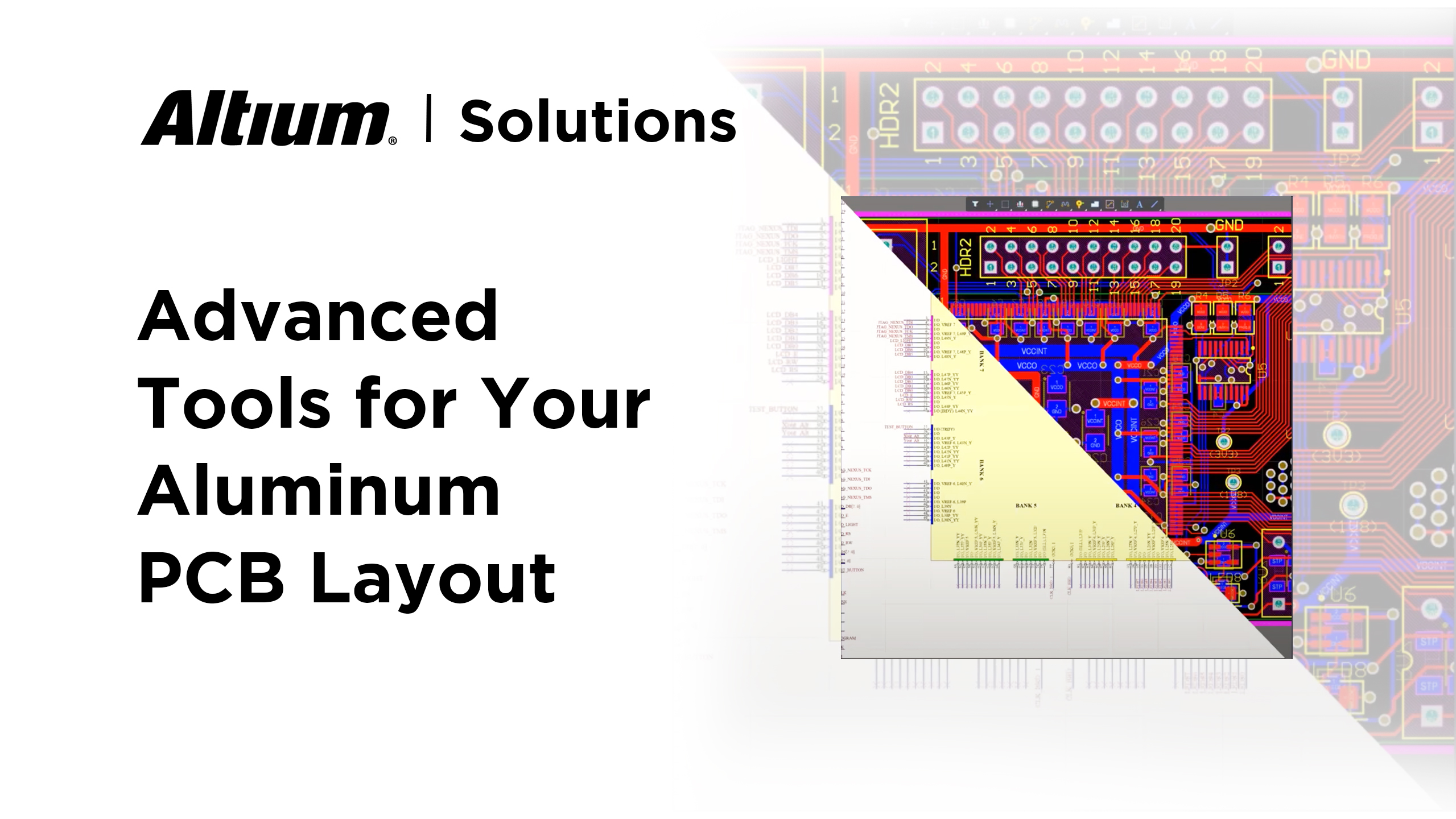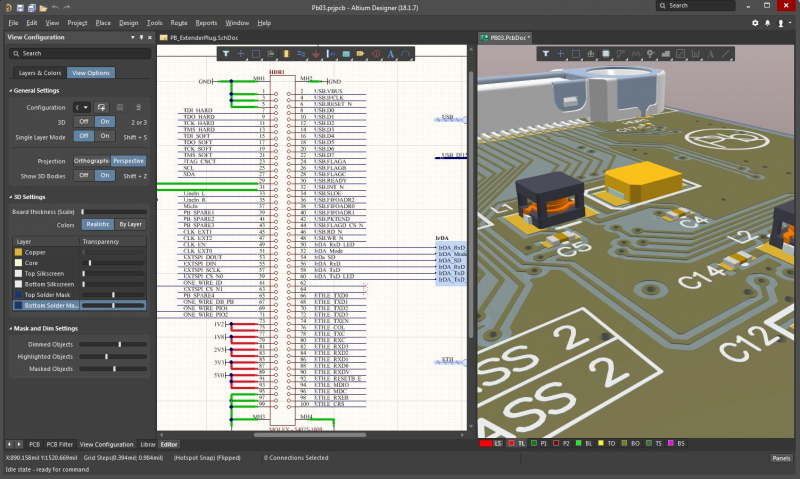The Best Printed Circuit Board Design Software for Your Aluminum PCB

Whether for thermal performance, electrical isolation, or mechanical strength, your aluminum PCB needs the precision of Altium Designer to meet your design requirements. Altium Designer allows almost any aspect of your circuit boards to be customized, including the metal core or backing on an aluminum PCB. Designers can also specify other materials in their documentation for their fabricator, such as ceramics, aluminum flex PCBs, or other specialty materials. Take control over all aspects of your PCB with Altium Designer.
ALTIUM DESIGNER
The most powerful, modern, and easy-to-use PCB design tool for professional use.
More designs are using metal core PCBs. The metal substrate provides a mechanically robust core material with high thermal conductivity, while the dielectric layer allows components to be mounted on the board with standard manufacturing processes. MCPCBs are being used for LED boards, solid state relays, and power conversion PCBs to name a few applications. The most commonly used metal in these MCPCBs is an aluminum base, which might be mounted on the back side of the board, or as an aluminum core layer with a separator membrane.
If you work in power conversion or on systems that need rugged constructions, you may find yourself designing an aluminum PCB. There are other materials that can provide high thermal conductivity and mechanical strength, such as alumina ceramic or flexible aluminum PCBs. No matter which materials you want to use in your PCB stackup, Altium Designer is here to help you design and document all aspects of your circuit board. Take control over everything in your next printed circuit board layout with Altium Designer.
Getting Started with Aluminum PCB Design
All aluminum PCBs start by determining a PCB stackup, layer count, and the materials used in each portion of the PCB. Aluminum can be placed in the core layer of the board and bonded to the surrounding dielectric layers with a separator membrane, or it can be used as a back-side mounted plate that takes up a surface layer. If placed on the back side of the board, a cutout can be placed to provide space for connectors, transformer mounting, or other components.
Ceramics are an alternative material to aluminum-core or aluminum-backed circuit boards. These materials provide extremely high thermal conductivity and can be fabricated as 2-layer PCBs. However, they are hard, brittle substrates that can be expensive to fabricate, and they cannot be constructed as multilayer PCBs. One big difference between standard FR4 laminates, metal-core boards, and ceramics is their thermal conductivity, which is summarized below:
Aluminum Circuitry Requires the Best PCB Design Software
After defining your layer stackup, you’ll need to capture your schematics and start placing parts in your PCB layout. Altium Designer gives you the tools you need to ensure your board meets important DFM guidelines for aluminum PCBs. By defining rules and constraints on routing and component placement, Altium Designer helps ensure your aluminum PCB is manufacturable and reliable.
- Aluminum PCBs are used in LED boards, power conversion products, and other high-temperature or high power applications.
Learn more about Altium Designer’s easy to use schematic capture application.
- Your PCB stackup needs to be created with standard materials and via definitions. Altium Designer’s stackup manager can be used with any PCB stackup, including aluminum PCBs.
- If you need a substrate with a very large thermal conductivity value, then you might consider using a ceramic PCB substrate material instead of aluminum and FR4.

Superior place and route tools combined with a native 3D engine will give you the advantage
Advanced Tools for Your Aluminum PCB Layout
Altium Designer includes a range of PCB layout utilities for any circuit board, including aluminum PCBs. Smart component placement, automated rules checking, integrated schematic capture, and interactive routing tools are all built into Altium Designer. If you need to manage multiple variants of your aluminum PCB design, there’s no problem as Altium Designer has you covered. You can track and manage your design variants easily with the variant tools in Altium Designer.
Native 3D design tools also help you build complex, high-quality designs. Circuit boards need to fit into their system enclosures and interact with other mechanical features, and here is another area where Altium Designer will really be able to help you. With the native 3D engine technology that Altium is well known for, you will be able to verify and adjust your component placement in full 3D. You also will be able to import your mechanical system design data into your layout to verify your design against the entire system which is very beneficial for rigid-flex PCB designs.
Altium Designer Has All the Functionality You Need in One Application
Every design tool in Altium Designer is placed in a single program that runs on top of a unified rules-driven design engine. Your design tools will use the same set of circuit board design and layout data, and you won’t need to use different programs to access basic design features. You can design with maximum productivity when you use Altium Designer for your advanced PCBs.
- Using Altium Designer’s schematic editor is easy and intuitive, and you will quickly be creating the circuitry for your aluminum PCB design.
Learn more about Altium Designer’s easy to use schematic capture application.
- Component placement is more important in an aluminum PCB than ever, and Altium Designer has smart component placement functions to help you get it done right.
Learn more about Altium Designer’s smart component placement features.
- With Altium Designer you will have all the interactive routing functionality that you will need to route a quality aluminum PCB.
Learn more about your interactive routing options in Altium Designer.

Control all aspects of your metal-core PCB when you use Altium Designer.
Manufacture Your Aluminum PCB Successfully
When your aluminum PCB design is finished, you’ll need to prepare your design for your manufacturer and assembly. The aluminum PCB manufacturing process involves cladding the aluminum core with an adhesive separator layer and bonding the PCB laminates on each side of the aluminum plate. Any through-holes in the aluminum plate layer are drilled out with a larger diameter and are filled with an insulating gel to prevent shorts. Finally, once the stackup is created, through-holes are plated and the surface layers are finished with solder mask and overlay.
The power of Altium Designer comes from the ability to quickly generate these important instructions for an aluminum PCB manufacturer. It’s easy to auto-generate all of your manufacturing drawings, fabrication files, drill files, bills of materials, and any other documentation with the OutJob utility in Altium Designer. In addition, the built-in Draftsman tool helps you auto-generate high-quality 3D drawings of your PCB design for fabrication and assembly. Best of all, you can place specific instructions for your manufacturer to ensure they manufacture your aluminum PCB correctly.
Take Control of Design and Manufacturing with Altium Designer
When you can take control of your manufacturing documentation, you can ensure your production run will be successful. Altium Designer helps you stay productive with reusable batch output files, which let you quickly generate standardized fabrication and assembly documentation for any manufacturer. You won’t have to manually recreate files each time you send a job for manufacturing, you can take control over your manufacturing data.
- Altium Designer includes everything needed to define your aluminum PCB stackup, build your PCB layout, and prepare for manufacturing in a single program.
Learn more about the unified design environment in Altium Designer.
- With Draftsman in Altium Designer, you can auto-generate high-quality drawings in a fraction of the normal time. You can also add annotations and special instructions for your fabricator quickly and easily.
Learn more about generating your manufacturing drawings in Altium Designer.
- When you’re ready to share your project with other PCB designers or your manufacturer, Altium 365 lets you instantly share your circuit board design and production data through Altium Designer or on the web.
Learn more about sharing your PCB project data with Altium 365.

Automated drawing creation along with other manufacturing output aids will keep you ahead
Aluminum PCB design doesn’t have to be difficult with the right set of PCB layout features. Altium Designer includes all the features you need to customize everything in your board, including material definitions for your layer stack manager. You can stay productive while designing high-reliability boards with alternative materials in Altium Designer.
Altium Designer on Altium 365 delivers unprecedented integration to the electronics industry until now relegated to the world of software development, allowing designers to work from home and reach unprecedented levels of efficiency.
We have only scratched the surface of what is possible to do with Altium Designer on Altium 365. You can check the product page for a more in-depth feature description or one of the On-Demand Webinars.
|
Material |
Thermal Conductivity |
|
FR4 laminates |
~0.3 W/(m·K) (in-plane), ~0.9 W/(m·K) (z-axis) |
|
Aluminum |
~1.8 W/(m·K) |
|
Alumina ceramic |
~6 W/(m·K) |
|
Aluminum nitride |
~180 W/(m·K) |
|
Silicon carbide |
~30 W/(m·K) |
|
Beryllia ceramic |
~325 W/(m·K) |
|
Boron nitride |
~30 W/(m·K) |
